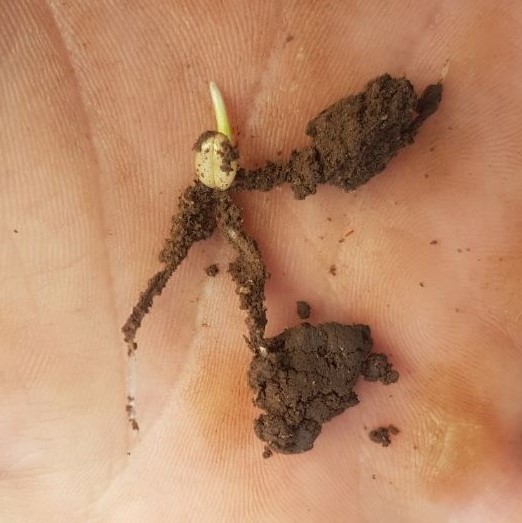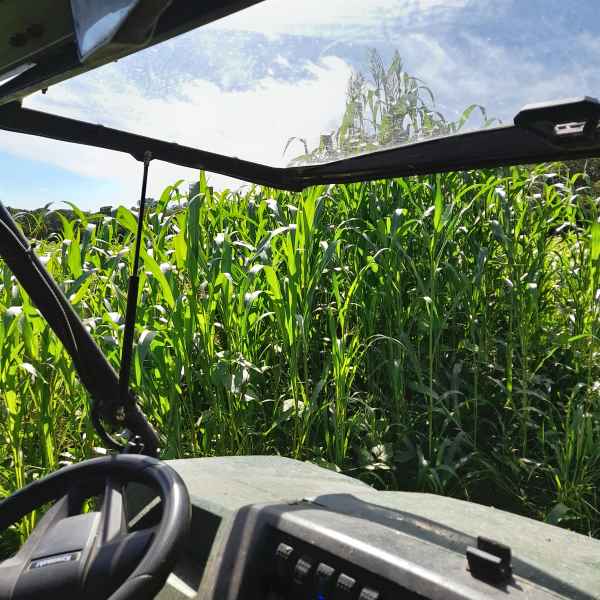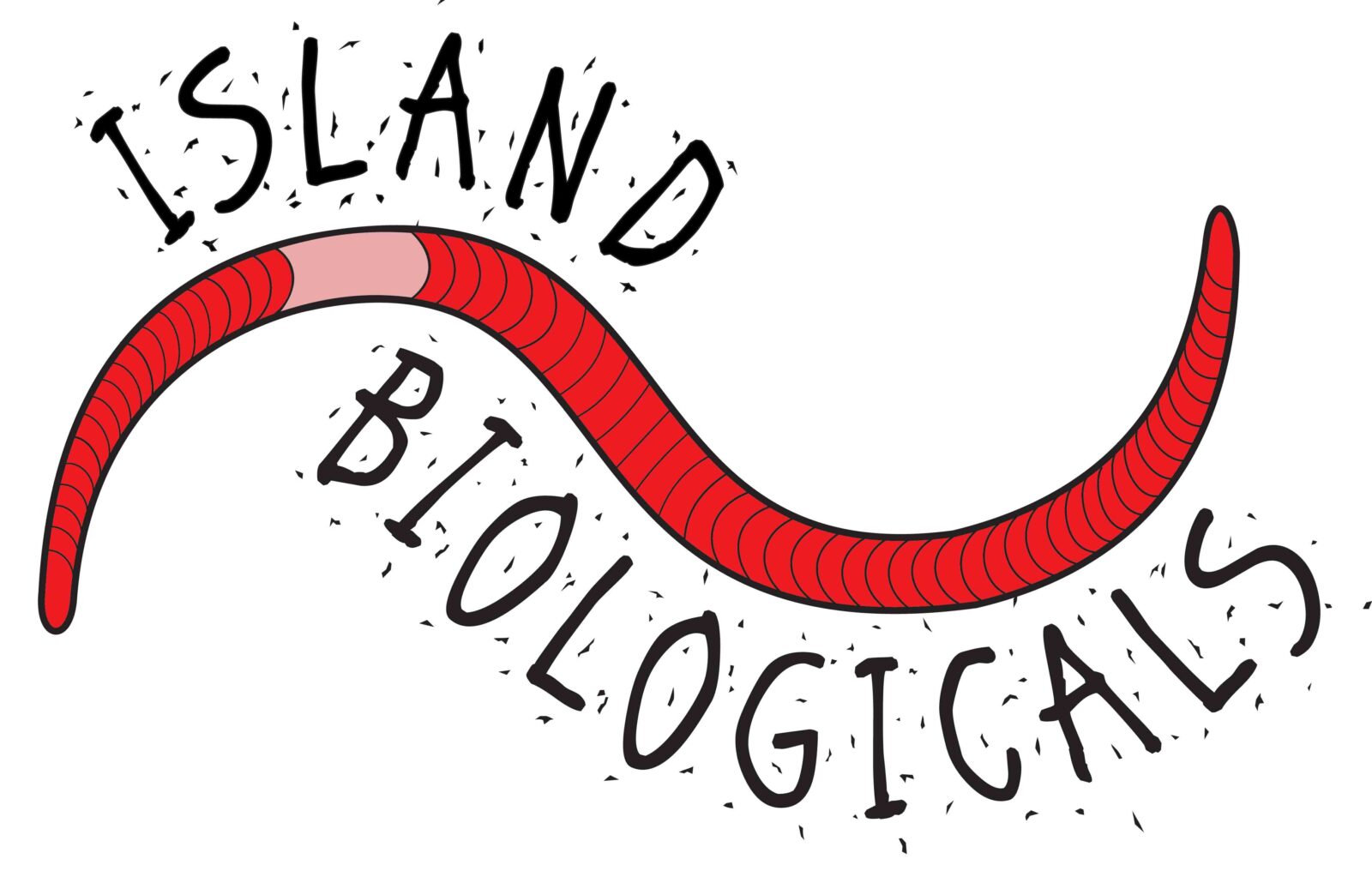Say you’re wanting to improve your soil (well, you get these emails so you probably are!). And you know you need to change things up, because you can see that what’s been happening on your land has been leading to some undesirable symptoms. Maybe compacted soils that just won’t hold the rain. Maybe weed problems, pest and disease problems in your cash crop, high vet bills, the need for ever increasing fertiliser inputs to get the same result, and the list goes on. You’ve heard that seeding with a multi species mix into your crop/ pasture/ fruit inter-rows can have good results, so you give it a go. But it under-performs dramatically. Disaster!
Or is it?
Let’s reframe how we measure success in a situation like this, where we have multiple desired outcomes. Traditionally, dry matter/ha is the be all and end all of success. But if you ALSO want to improve soil, and perhaps incorporate values like plant health, animal health, and your health; what does success look like now? Can you have your cake and eat it too??
Get real
First, let’s get real with our expectations. If your starting point is a paddock with sick soil, or you’re starting from a monoculture, or low succession plants (read: weeds) you are dealing with dysfunction. The true level of dysfunction could be very different (more or less) than what you think is. After all, no one sets out on purpose to create a dysfunctional system do they. It generally didn’t get like that in one season (though if you’re dealing with a post-fire situation, read this). Across much Australian farmland there has been decades, even centuries, of soil degradation. It’s not going to bounce back and be ‘perfect’ after one season. If you have been using nitrogen-based fertilisers your plants are akin to crack addicts. Asking them to go cold turkey won’t be pretty. After all, their whole soil-based support network has deserted them!
It’s not all bad news though. In the nitrogen scenario, Dr Christine Jones shares that in her experience, with the right support it takes only 3 years to get the necessary quota of nitrogen-cycling soil microbes back; which, we’re gonna say, is a whole lot quicker than how long it took for the problem to form. With good management you can see vast improvements within a few seasons – but not necessarily the first one. So, what’s the deal?
The root of soil healing
Let’s look at how soil heals. Conventionally, we are trained to see the soil and the seed as separate. We purchase the seed, push it in the soil, and the seed grows into a plant. If we also purchase X inputs, we can expect Y outputs. Unfortunately this is a furphy, which we discover (though perhaps don’t admit?) the first time the season is inclement and the crop fails.
In fact, the seed, subsequent plant, microbe and soil are indivisible; as science’s discovery of rhizophagy and the plant microbiome is demonstrating. The roots of the plant emit exudates tailored to producing a growing environment that will best suit that plant. The exudates feed soil microbes, and change moisture conditions around the roots. They are communication with the soil and with other plants.
Roots build soil. But what do we measure? Dry matter/ha – surface biomass. We care about how tall the plant grows up, when actually how tall the plant grows down is just as important. How tall the plant grows down is its drought resilience, its nutrition, and its investment into the successful growth of itself and its babies for years to come. So, perhaps that first season you didn’t get the upwards growth, but we challenge you to get a shovel and see whether you had better downwards growth!
I want to eat my cake!
We get that you need some kind of yield to make an income, and everyone would love the surety of the ‘seeds plus inputs equals year-in-year-out yield’ story. But let’s remember that it’s not the full story, and I bet no one selling urea ever mentioned that it comes with a side of chemical addiction and reduced resilience to harsh weather. You don’t make money from crop failures.
In farming everyone banks on the good years, right? That ‘failed’ multi species experiment was actually an investment into making more years’ good years down the track, regardless of the weather. If you had a variety of roots in the ground pumping out exudates, then you were witnessing soil-healing success. The trick is not to freak out at the perceived lack of above ground activity and do something like add synthetic fertiliser, or poison the ‘weeds’, reducing below ground root exudate activity.
If you’re worried about maintaining production, have a 3-5+ year implementation plan. Just start with one paddock. Have very smart use of inputs to reduce your overheads and financial risk (biostimulants are your friend! More on that below). Use simple monitoring to see what is happening in the soil (e.g. check out our Bring a Shovel blog). Observe everything. Learn to trust Nature’s processes, and persist.
The idea for this blog came about after Lee went to a talk and saw a picture of Col Seis, pasture cropping legend, waist deep in his wheat crop the first year he started to change things up. The thing was, he was sitting down. That beautiful crop wouldn’t even have been knee high! Thankfully he persisted, and that early investment in change now means that Col has highly profitable stacked enterprises – his Soils for Life case study shares that his “annual input costs reduced by over $120,000; soil carbon increased by 203% in 10 years; delivering three production lines from each paddock; improved wool quality (learn more from him at winona.net.au). It’s not just Col. Australia and the world over, healthy soils deliver profits.
Seeds as tools
Let’s look at our seed input as a process, rather than a product. Rather than being single season seeds in = expected dry matter/ha out; seeds can be a tool to improve the fertility, health, and productivity of your land over time. Using a diverse array of plants gives you a diverse array of roots and their exudates, and will bring more life to your soil. More life = more life.
Establishing root zones and allowing root exudates to go back in the soil is priming the system for the next thing. That first year might not look like a raging success but it is feeding the soil and setting you up for exponential growth in coming seasons.
Using biostimulants to help the process
Now we’ve shifted our way of seeing, we can ask ‘how can I use inputs to assist root exudation, to enable maximum profit in any climatic scenario over the next 5+ years?’ Good question. You may well benefit from fertilisers, but with this question the type and application style for them will be vastly different from those simply chasing short-term production [NB. Different from profit!]. More likely you will benefit from a product that stimulates nutrient cycling between soil and plant, and stimulates plant growth and healthy plant processes such as root exudation. These are the biostimulants. (If you want a breakdown of input types, check out our blog ‘Inputs Explained’.)
Biocast is a liquid vermicast biostimulant. In this scenario, its best use would be as a seed dressing. This is a very economical application method, but it’s also very effective. The earthworm-produced compounds in Biocast signal the seed to establish a relationship with the soil as a priority. What we, and our customers, observe is that the young seedling has much more root than shoot; and those roots have a thick rhizosheath (dredlocks) – exudation is happening and soil-building, plant-supporting microbes are coming to the party – see the photo below as an example. We have one very forward-thinking customer who coats inexpensive seed with Biocast just to get the benefits of this initial activity. He’s not interested so much in whether that particular seed or all they types of seed in his mix reach maturity, but in their ability to prime the soil for all the other things. His pastures are the best we’ve seen – see the photo below from our most recent tour. Biocast can also be used as a foliar to good effect if things need a kick along mid-season.

A newly germinated seed that had been dressed with Biocast. Note the significantly greater root than shoot growth, and the thick rhizosheath showing that this seed is already building soil.

Photo taken in April of a summer multi species planting at the Biocast customer’s property where seed is used as a biostimulant carrier and tool for increasing soil fertility.
Conclusion
In conclusion, yes, you can have your cake and eat it too, with a side of double choc ice cream and a cherry on top. You just need to stay the course, and support the connection between your plants and soil. Your first season results may not be indicative of changes happening, or what might happen next. Measuring dry matter per square metre doesn’t include how much you spent to get the result, or factor in any damage caused. Creating fertility and true profit is a process, and you will measure it best by grabbing a shovel and looking for dredlocks on your plants’ roots.
Would you like to try Biocast to help establish a multi species planting, or ease your transition to less synthetic inputs?
Call Lee on 0429 197 596 if you would like to discuss what this could look like for you, or order via our online shop.
